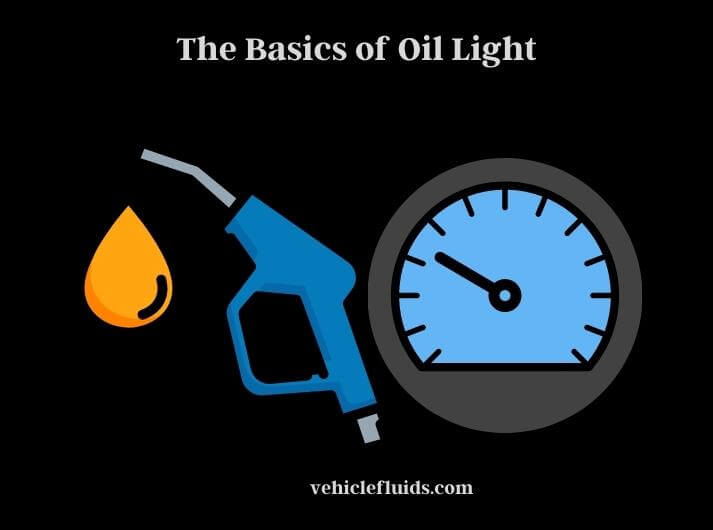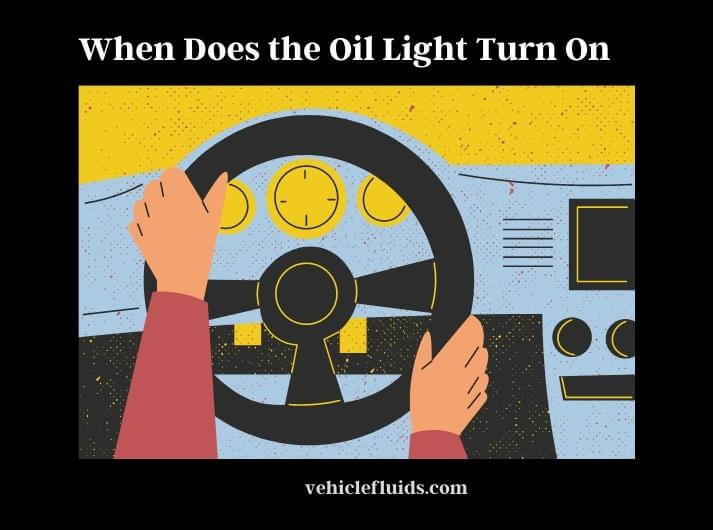When it comes to maintaining your vehicle, one of the most critical components to check is the engine oil. The engine oil keeps your car’s engine lubricated, reducing friction and preventing overheating. If your car’s oil level drops too low, it can cause significant engine damage. Without sufficient oil, the engine can suffer significant damage, leading to costly repairs or even engine failure. This is why it’s crucial for drivers to pay attention to their car’s oil light.

That’s why most cars have an oil warning light that lets you know when the oil pressure is low or the oil level is insufficient. We will discuss what an oil light looks like in a car and what it means when it turns on.
The Basics of Oil Light
An oil light is a dashboard warning light that indicates low oil pressure or low oil levels. It’s designed to alert drivers when there’s a problem with their car’s oil system, allowing them to take action before any serious damage occurs. The oil light is typically located in the instrument cluster, along with other warning lights such as the battery light and the check engine light.

Types of Oil Light
There are two main types of oil lights that you may encounter in your car: the dash-mounted oil light and the oil pressure gauge. The dash-mounted oil light is the most common type and is usually a small icon that looks like an oil can. The oil pressure gauge, on the other hand, is a dial or digital display that shows the current oil pressure in the engine. The oil pressure gauge is more accurate, and the dash-mounted oil light is easier to understand and can be a useful early warning system for potential problems.
What Does an Oil Light Look Like?
Oil light symbols can vary depending on the make and model of your car. However, there are some common symbols that you may see. The most common symbol is an oil can or oil lamp. Some cars may also display a “Check Oil” or “Oil Level” warning. The color of the oil light can also vary, with red or amber being the most common. Red is usually used to indicate an immediate problem that requires immediate attention, while amber indicates a less severe issue.
Why Do Cars Have Oil Lights?
Before we dive into what an oil light looks like, it’s essential to understand why cars have this warning light. As we mentioned earlier, engine oil is crucial for keeping the engine running smoothly. When the oil level drops too low, the engine may not get the lubrication it needs, leading to overheating and damage to internal engine parts. The oil light is designed to alert drivers when there is a problem with the oil system, allowing them to take action before it’s too late.
When Does the Oil Light Turn On?
The oil light turning on is typically an indication that something is wrong with your car’s oil system. There are a few reasons why the oil light might turn on:
Low Oil Pressure
Low oil pressure is one of the most common reasons why the oil light turns on. Low oil pressure can be caused by a leak in the oil system or a faulty oil pump. When the oil pressure drops below a certain level, the oil light will turn on.

Low Oil Level
Another reason why the oil light may turn on is due to a low oil level. If the oil level is low, the engine may not be getting the lubrication it needs, causing the oil light to turn on. It’s essential to check your car’s oil level regularly and top it off as needed.
Faulty Oil Sensor
Sometimes, the oil light may turn on even if there is no problem with the oil system. This can happen if the oil sensor is faulty and sends false readings to the car’s computer. In this case, you may need to have the sensor replaced to fix the issue.
What Should Do When the Oil Light Turns On?
If the oil light turns on while you’re driving, it’s essential to take action right away. Here’s what you should do:
Check Your Oil Level
The first thing you should do is check your car’s oil level. Pull over to a safe location, turn off the engine, and wait a few minutes for the oil to settle. Then, remove the dipstick and check the oil level. If the level is low, add oil as needed.
Check for Leaks
If the oil level is fine, the next step is to check for leaks. Look under the car for any signs of oil leaks, such as puddles or stains on the pavement. If you notice any leaks, it’s essential to have them fixed right away.
Have Your Car Inspected
If you’re unsure what’s causing the oil light to turn on, it’s essential to have your car inspected by a mechanic. They will be able to diagnose the issue and make any necessary repairs before it becomes a more significant problem.
How Can You Prevent the Oil Light from Turning On?
Preventing the oil light from turning on is relatively simple. Here are a few tips to keep in mind:
Check Your Oil Level Regularly
Checking your car’s oil level regularly is the best way to prevent the oil light from turning on. It’s recommended to check your oil level at least once a month or before long trips.
Change Your Oil Regularly
Regular oil changes are essential for keeping your car’s engine running smoothly. It’s recommended to change your oil every 3,000 to 5,000 miles, depending on your vehicle’s make and model.
Fix Leaks Right Away
If you notice any oil leaks, it’s essential to have them fixed right away. Ignoring leaks can lead to low oil levels and engine damage.
FAQs
What Should You Do if the Oil Light Turns on While Driving?
If the oil light turns on while driving, pull over to a safe location, turn off the engine, and check your oil level. If the level is low, add oil as needed. If the level is fine, have your car inspected by a mechanic.
How Often Should You Check Your Car’s Oil Level?
Check your car’s oil level at least once a month or before long trips. This is because it’s not uncommon for cars to burn a small amount of oil over time, and checking your oil level regularly can help you catch any potential issues before they become major problems.
How Often Should You Change Your Car’s Oil?
Change your car’s oil every 3,000 to 5,000 miles, depending on your vehicle’s make and model.
What Causes Low Oil Pressure?
Low oil pressure is a serious issue that can lead to significant engine damage if left untreated. There are several potential causes of low oil pressure, including:
- Low oil level
- Low oil level
- Clogged oil passages
- Faulty oil pressure sensor
- Worn engine bearings
- Thick or old oil
If you’re experiencing low oil pressure, it’s important to have your car inspected by a qualified mechanic as soon as possible. Ignoring the problem can lead to serious engine damage or even engine failure. Depending on the cause of the low oil pressure, the solution may be as simple as adding more oil or replacing a faulty sensor, or it may require more significant repairs, such as replacing the oil pump or engine bearings.
Last Point
The oil light is a crucial component of your car’s warning system. By paying attention to the oil light, you can catch potential problems early and prevent serious engine damage. If the oil light turns on, it’s important to take action immediately and address the issue before it gets worse.
Remember to check the oil level regularly and have your car serviced according to the manufacturer’s recommended schedule. If you take care of your car’s oil system, you can keep your engine running smoothly for years to come.
